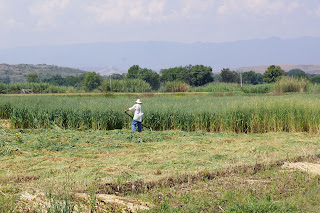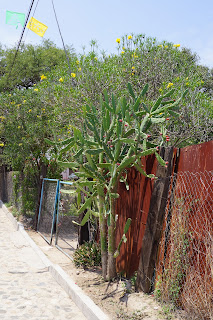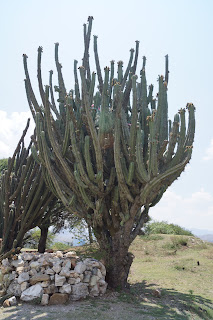Winding our way through small plots of farmland on our way to San Jose el Mogote, a small archaeological site north of Oaxaca City, we reflected on the toughness of the elderly men tilling the fields by hand and plowing with horses. Stunning Brahma bulls obstructed our path at one point, as hummingbirds and falcons pulled our gaze upward. Members of the farming communities shouted greetings and requested to be photographed, as they pointed us toward our destination. A traveler's dream! We couldn't help but feel spoiled as we strolled through the countryside, stopping to admire colorful graffiti under a bridge, remark at a Vans sneaker stuck in the mud, or marvel at two dogs' cooperative hunting skills as they captured a squirrel. It was such an idyllic day that I even drank half of a certain ubiquitous cola beverage without worrying about the sugar or carbonation for more than about a half hour (is that an achievement?).
Anyway, on to the photos:
The fundamental grain to Mexican cuisine: maiz. First cultivated here about 6,000 years ago, most corn consumed by modern day Mexicans comes from the American Midwest, as a result of free trade agreements that made it cheaper to import many food products than to subsidize them here.
Below, Harold observes a group of falcons passing overhead.
A man works his parcel of land manually, his horse grazing nearby. Below, a tunnel leads to another farming community on the northern end of Oaxaca City.
Above, the colorful graffiti beautifies the underpass on the way to San Jose el Mogote.
We pass a man driving a horse trailer, and we ask for directions for a third time.
More uncomfortable-looking manual farm labor, complete with altitude, heat and humdity.
Kudos to these guys!
A horse shows off a brilliant coat and mane for us.
Prickly pear blossoms. Leaves from this cactus, known as the nopal, form part of a delicious salad consumed as part of a vast Mexican cuisine, largely unknown in the United States. The fruits, called tuna (yep, you read that right), are sweet and seedy, and frequently consumed in frozen desserts.
Some sort of wild chili pepper we were unable to identify. Hundreds of varieties of chilies, fresh, dried, ground, whole, are used as the basis for Mexican cooking.
Village of San Jose el Mogote.
Another village scene.
Amusing faces on Zapotec containers. The site we visited was once a prominent Zapotec town in around the tenth century AD, and later became a hacienda subsequent to the Spanish Conquest. The museum contains Zapotec artifacts, as well as information regarding the owners and employees of the hacienda, resulting in a short, sweet, well-presented museum experience.
The Zapotecs incorporated clay figures in dramatic productions. Not sure what is going on here....
This is where we are in Mexico! Just one state away from Guatemala to the south. Oaxaca is much-loved among artists, both Mexican and foreign, and has a strong artisan craft tradition. Gastronomy is a prominent part of the culture here, and though it is among the poorest states in Mexico, the affordability and quality of food is overwhelming. We've spent a good amount of time stuffing our faces!
In the middle of the state is where we currently are, about six hours to Mexico City by bus, and six hours to the coast, which we have yet to visit....
I love burros! Not a burro will go unphotographed by me.
Reaching the archaeological site, much of which remains to be excavated. This area, and much of Mexico, is full of non-touristy ruins such as these.
Giant blooming cactus.
The ice cream man passes through the farming communities.
The view from San Jose el Mogote.
El mogote.
According to my taste, one of the tackier houses I've laid eyes on. Pepto-bismol comes to mind.
Hacienda San Jose el Mogote.
Adobe/dung bricks.
Heading back with sore legs and a serious appetite.... I think the neighborhood Zumba class will have to wait till tomorrow.


























No comments:
Post a Comment